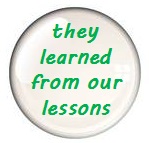Having spent the last few weeks exploring what’s wrong with lessons learned, it’s time to turn our attention towards the elements that contribute to successful organisational learning.
As we piece this puzzle together, one of the most important principles to bear in mind is that of knowing your customer.
It sounds obvious, but in my experience it’s often overlooked. Just who is customer for the learning?
1. The current team.
One clear customer is the team who are conducting the review. A well-facilitated review will not only surface technical, commercial and process-related learning, but also personal, behavioural and team-related insights. Even if the activity was a one-off, never-to-be-repeated project, there will always be learning relevant to each individual – provided the team explores the right questions.
Imagine a research team is working on a vaccine for an incurable disease. After years of experimentation, analysis and a little luck, they stumble upon the antidote. The team is ecstatic – they have a formula in their hands that could improve the lives of thousands of people. So they secretly inoculate themselves, disband the team and each individual starts on their next challenge.
Now imagine the outcry! That would be outrageous – a waste of extensive research. Commercially disastrous and selfish to the point of immorality!
There is a research team hidden in every operational project we do – it’s just that we fail to help them realise and multiply the value in what they have discovered - which takes us to customer type number 2:
2. The next team. One year ago, a large number of representatives from the London Organising Committee of the Olympic Games conducted an extensive debrief. That debrief wasn’t carried out in London. Instead, it was conducted in Rio de Janeiro, in the presence of the Rio 2016 team, facilitated by the IOC. Not only that, but the time was deliberately managed such that 50% of each day was available for connecting, networking and asking further questions., as well as exchanging documentation. The customer was clear – it was the next team.
Sometimes we know who exactly the next team (or teams) will be, and we can set up relationships, staff transfers, conversations, forums to ask questions, site visits, peer assists, peer reviews. The IOC do all of this very well. When we know who our customers are, then we can connect the supply with demand. Dialogue-based approaches are the most effective mechanisms for this.
However, there are times when we don’t know who the next team will be – but we’re sure that there will be one at some time. We can’t afford to wait until the demand surfaces, because the supply (the current team) will have already been disbanded, and may well have left the organization. In these cases we do need to capture some record of the context and the learning, and where it is relevant, to express this as principles, propositions, recommendations or specific advice for the next team, whoever they might be.
We need to ask the right questions (more on this the next post); questions which make the current team think about the needs of an imaginary future team:
“What would you say to a team about to start on a similar project?"
"If you had just 5 minutes with them, what key pieces of advice would you give them, based on your experiences?"
"How could they repeat your successes; how could they ensure that they avoid the low points you faced?”
In practice, it can be difficult to convince a busy team that they need to invest time together for the benefit of some future imaginary team. They know it makes sense, but they usually have other priorities, even if there is a requirement in the project process that they need to comply with. Compliance rarely generates thoughtful dialogue.
You will want to start with them as the customer, and bring the questions around to the future once they have warmed up, and seen some personal benefit. You may need to appeal to people’s professionalism and pride to get them to engage in the idea of being recognized for leaving a legacy. Indeed, some organisations have recognition schemes in place for exactly this. (ConocoPhillips’ “Gather” award, and Syngenta’s “Embed” award are both examples of this.)
Of course, when we take on a customer mindset, we need to consider more than just what they need to know. We have to think equally as hard about how they would like to receive this knowledge. You can bet that they don’t want a copy of a flipchart sporting a set of bullet points from a meeting that they were not present at! They would probably like to have context, contacts, reasons for decisions, artifacts, quotations, narrative, references, top tips, things to avoid… – all nicely structured and easy to navigate.
When we understand that we have knowledge customers, then we need to consider our knowledge products.
More on this at a later date.
3. The Organisation itself.
So the current and future teams are clear enough, but how does the organisation become a customer?
It’s the best way I could think of to describe the idea of improving the structural capital – the processes, guidelines, protocols, standards, policies, training, development and formal ways of working. I have had the privilege of spending time with the IOC over the past two years, and their approach to closing the loop and translating learning into technical guidance through their technical manuals is a great example of this.
An effective “lessons learned programme” does to simply pass the baton to the next team, neither does if make it’s goal in life the develop a library of lessons learned. The focus should always be on improvement. The question should be “how do we ensure that actions follow which remove the risk, or bake-in the benefits that our learning has uncovered?”. I covered this in my BMW shaggy-dog story earlier last year.
The question “what have we learned?” should be followed by “what should we do about this?”. A learning log needs to have an actions log.
When we apply KM in Safety context we do this without another thought. If someone is killed, injured or in the event of a near miss, a sequence of safety-related review processes are initiated, root causes are understood, risks mitigated, procedures updated, communication planned and training delivered.
We are good at closing the loop between a moment of learning and a permanent change in the structural capital. Hopefully this is because we don’t want to kill or injure anyone, and hence care enough to make someone accountable for looking for risks and actions in every fragment of learning.
In my experience, other topics don’t receive this level of attention, even though the commercial value at stake might be significant. Something we could learn from there.
False customers.
Just a few words about other stakeholders who are sometimes unhelpfully referred to as the customer for learning.
The customer is the project management process.
Never heard anyone say that? Well, perhaps you’ve heard them express the same sentiment when them say: “the process says we need to have a review before proceeding to the next stage gate”. That’s more or less the same mindset. We need to raise the sights of our project teams to see the real customer – themselves, the next team, or the betterment of the organization, which ultimately will improve relationships with a real external customer.
The customer is the regulator.
In some regulated businesses, there is an expectation that effective learning and improvement cycles are in place. This is a good thing! Sadly, the regulators often look for evidence of inputs (because that’s what how they can measure compliance and consistency) rather than outputs (where the customer creates the value). This can launch an industry of lessons logs and registers, unproductive reviews and ineffective debriefs, again the real customer has been lost and regulatory compliance has become a distraction.
This can be difficult, as nobody wants to do the work twice. I recommend a dialogue with the regulating body to find out what they are actually looking for, rather than making assumptions that they have a preferred format. In my experience, regulators are specialists in their subject matter, but not specialists in organisational learning. Engage them in a discussion about your preferred approach and propose different or additional sources of evidence of learning and transfer (for example: meetings in schedules, testimonies from individuals, candidates for recognition schemes).
Let's keep our focus on the true customers, and magnify the benefits.














